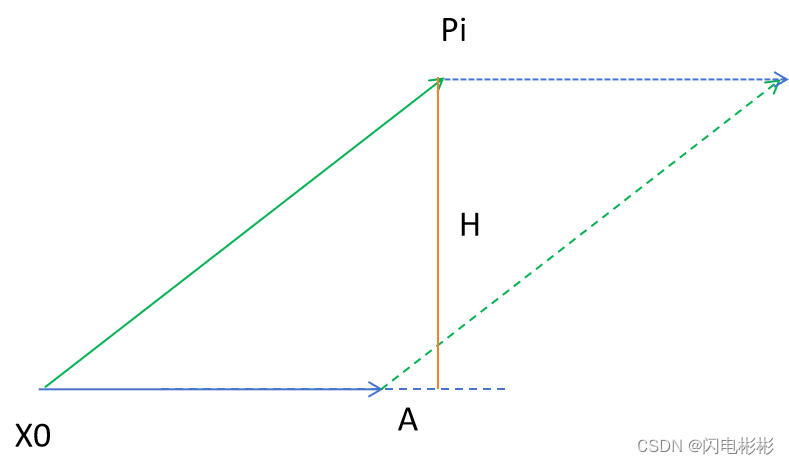最小二乘直线拟合算法
欢迎关注更多精彩
关注我,学习常用算法与数据结构,一题多解,降维打击。
本期话题:最小二乘直线拟合
背景
ptb认证
ptb是对几何体拟合算法的认证。
主要涉及3D直线,3D圆,平面,球,圆柱,锥。
官方会给出点云信息,由用户将拟合结果上传到官方服务器进行对比答案,返回结果。
拟合有很多种度量标准,不同的标准出来的答案可能不完全精确。所以,要通过认证必须用官方给定的度量方法,具体可以参考论文。
认证精度要求

对于位置类型,比如圆心,直线的点等,误差不能超过0.0001mm。
对于角度,比如圆锥的开角,误差不能超过0.0000001rad。
对于方向,与标准值夹角不能直过0.0000001rad。
对于半径,误差不能超过0.0001mm。
学习资料
论文资料
Forbes, Alistair B.: Least-squares best fit geometric elements, NPL Report DITC 140/89 , ISSN
0262-5369, 40 pages, revised edition, 1991
由NPL发表。里面介绍了所有ptb认证的拟合算法。
直线拟合输入和输出要求
输入
- 8到50个点,全部采样自直线上。
- 每个点3个坐标,坐标精确到小数点后面20位。
- 坐标单位是mm, 范围[-500mm, 500mm]。
tips
输入虽然是严格来自直线,但是由于浮点表示,记录的值和真实值始终是有微小的误差,点云到拟合直线的距离不可能完全为0。
输出
- 直线上1点p,用三个坐标表示。
- 直线方向k,用三个坐标表示,需要单位化。
精度要求
- p点到标准直线距离不能超过0.0001mm。
- k与标准法向的夹角不能超过0.0000001rad。
直线优化标函数
根据论文,直线拟合转化成数学表示如下:
直线参数化表示
- 直线上1点X0 = (x0, y0, z0)。
- 方向单位向量A=(a,b,c)。
点到直线距离
第i个点 pi(xi, yi, zi)。

可以根据叉乘长度为面积,面积又等于底乘高,点到直线的距离是叉乘结果除以底。底是单位向量。
d i = H = ∥ ( p i ? X 0 ) × A ∥ ∥ A ∥ d_i = H =\frac { \left \| (p_i-X_0)\times A \right \|}{\left \| A \right \|} di?=H=∥A∥∥(pi??X0?)×A∥?
d i = ∥ ( p i ? X 0 ) × A ∥ d_i = \left \| (p_i-X_0)\times A \right \| di?=∥(pi??X0?)×A∥
展开一下:
d i = ( u i 2 + v i 2 + w i 2 ) d_i = \sqrt{(u_i^2+v_i^2+w_i^2)} di?=(ui2?+vi2?+wi2?)?
u i = c ( y i ? y 0 ) ? b ( z i ? z 0 ) u_i = c(y_i-y_0)-b(z_i-z_0) ui?=c(yi??y0?)?b(zi??z0?)
v i = a ( z i ? z 0 ) ? c ( x i ? x 0 ) v_i = a(z_i-z_0)-c(x_i-x_0) vi?=a(zi??z0?)?c(xi??x0?)
w i = b ( x i ? x 0 ) ? a ( y i ? y 0 ) w_i = b(x_i-x_0)-a(y_i-y_0) wi?=b(xi??x0?)?a(yi??y0?)
最小二乘优化能量方程
能量方程 E = f ( X 0 , A ) = ∑ 1 n d i 2 E=f(X0, A)=\displaystyle \sum _1^n {d_i^2} E=f(X0,A)=1∑n?di2?
上式是一个6元二次函数中,X0, A是未知量,拟合直线的过程也可以理解为优化X0, A使得方程E最小。
上述方程中向量的值不确定,所以并不好解,一般直线拟合会对协方差矩阵求特征向量来得到直线方程,具体可以看下面的主成分分析法。
拟合&测试基类设计
基类主要放一些公共方法和规定具体实现类要实现的算法。
具体在调用时,都用基类为载体,减少代码量。
拟合基类
#include <Eigen/Core>
#include <vector>
#include "GeometryTypes.h"
namespace Fitting {
using Matrix = Eigen::Matrix<double, Eigen::Dynamic, Eigen::Dynamic, Eigen::RowMajor>;
/* getCenter
获取点云中心
*/
Eigen::Vector3d getCenter(const std::vector<Eigen::Vector3d>& points);
/* moveCenter
* 将中心移至0点
*/
void moveCenter(const Eigen::Vector3d center, std::vector<Eigen::Vector3d>& points);
/* getRotationByOrient(Eigen::Vector3d orient);
* 返回一个旋转矩阵使得向量与Z轴平行
*/
Eigen::Matrix3d getRotationByOrient(Eigen::Vector3d orient);
class FittingBase {
protected:
Eigen::Matrix3d U;
std::vector<Eigen::Vector3d> transPoints;
/* Jacobi
* 构造jacobi矩阵
*/
virtual Matrix Jacobi(const std::vector<Eigen::Vector3d> &points)=0;
/* findNext
* 迭代1次得到解delta
*/
Eigen::VectorXd findNext(const std::vector<Eigen::Vector3d>& points);
/* beforHook
* 每次迭代前的准备工作
*/
virtual void beforHook(Eigen::VectorXd& a0, const std::vector<Eigen::Vector3d>& points)=0;
/* afterHook
* 迭代后更新答案
*/
virtual void afterHook(const Eigen::VectorXd& xp)=0;
/* 获取 d数组
*/
virtual Eigen::VectorXd getDArray(const std::vector<Eigen::Vector3d>& points)=0;
// GetInitFit 返回是否拟合成功
virtual bool GetInitFit(const std::vector<Eigen::Vector3d>& points)=0;
// iteration
double iteration(const std::vector<Eigen::Vector3d>& points);
/* F
* 距离函数
*/
virtual double F(const Eigen::Vector3d& p)=0;
/* 获取 最小二乘残差
*/
virtual double GetError(const std::vector<Eigen::Vector3d>& points) = 0;
/* 获取 结果
*/
virtual void Copy(void* ele) = 0;
public:
// Fitting
double Fitting(const std::vector<Eigen::Vector3d>& points, void* ele);
};
}
测试基类
namespace Fitting {
const double POSITION_MAX_DST = 0.0001, ORIENTATION_MAX_DST = 0.0000001, ANGLE_MAX_DST = 0.0000001, RADIUS_MAX_DST = 0.0001;
void writePoint(FILE *fp, const Point &p);
void writeNumber(FILE *fp, double n);
// 比较直线点是否一致
bool lineCmp(const Eigen::Vector3d &vec1, const Point &p1, const Point &p2);
bool lineCmp2D(const Eigen::Vector3d &vec1, const Point &p1, const Point &p2);
// 比较半径
bool radiusCmp(double r1, double r2);
// 比较法向是否一致
bool orientationCmp(const Eigen::Vector3d &vec1, const Eigen::Vector3d& vec2);
bool orientationCmp2D(const Eigen::Vector3d &vec1, const Eigen::Vector3d& vec2);
// 比较角度
bool angleCmp(double angle1, double angle2);
// 比较点位置
bool positionCmp(const Point &p1, const Point &p2);
/*
测试基类
*/
class TestBase {
protected:
// 测试用例路径和文件名
string suffixName, fileName;
vector<Point> points;
public:
TestBase() {}
TestBase(string _suffixName, string _fileName): suffixName(_suffixName), fileName(_fileName) {}
void SetFile(string _suffixName, string _fileName);
void readPoints();
virtual double Fitting()=0;
virtual bool JudgeAnswer(FILE* fp) = 0;
virtual void ReadAnswer() = 0;
virtual void SaveAnswer(FILE* fp) = 0;
};
}
PCA主成分分析法
学习资料:
https://www.bilibili.com/video/BV1E5411E71z/?spm_id_from=333.337.search-card.all.click&vd_source=fb27f95f25902a2cc94d4d8e49f5f777
算法过程
- 计算出所有点平均值 c e n t e r i d ( x  ̄ , y  ̄ , z  ̄ ) centerid(\overline x,\overline y,\overline z) centerid(x,y?,z) , 作为直线上1点。
- 构建矩阵 A = [ x 1 ? x  ̄ y 1 ? y  ̄ z 1 ? z  ̄ x 2 ? x  ̄ y 2 ? y  ̄ z 2 ? z  ̄ . . . . . . . . . x n ? x  ̄ y n ? y  ̄ z n ? z  ̄ ] A=\begin {bmatrix} x_1-\overline x& y_1-\overline y & z_1-\overline z \\ x_2-\overline x& y_2-\overline y & z_2-\overline z\\ ... & ... &... \\x_n-\overline x& y_n-\overline y & z_n-\overline z \end {bmatrix} A= ?x1??xx2??x...xn??x?y1??y?y2??y?...yn??y??z1??zz2??z...zn??z? ?
- 对矩阵A进行SVD分解,取右特征值矩阵最大特征值所对应列作为直线的法向。
代码实现
代码链接:https://gitcode.com/chenbb1989/3DAlgorithm/tree/master/CBB3DAlgorithm/Fitting
拟合代码
#include "FittingLinePCA.h"
#include "FittingBase.h"
#include <Eigen/Dense>
namespace Gauss {
using namespace Fitting;
double F(const Line& line, const Point& p) {
return (p - line.BasePoint).cross(line.Orient).squaredNorm();
}
double GetError(const Line& line, const std::vector<Eigen::Vector3d>& points) {
double error = 0;
for (auto& p : points) {
error += F(line, p);
}
return error / points.size();
}
double FittingLinePCA::FittLine2D(const std::vector<Point>& points, Line2D& line) {
return 0;
}
double FittingLinePCA::FittLine3D(const std::vector<Point>& points, Line& line) {
auto center = Fitting::getCenter(points);
std::vector<Point> copyPoints = points;
Fitting::moveCenter(center, copyPoints);
Eigen::MatrixX3d A(copyPoints.size(), 3);
for (int i = 0; i < copyPoints.size(); ++i) {
A.block<1, 3>(i, 0) = copyPoints[i];
}
Eigen::JacobiSVD<Eigen::MatrixX3d> svd(A, Eigen::ComputeFullU | Eigen::ComputeFullV);
line.Orient = svd.matrixV().block<3, 1>(0, 0);
line.BasePoint = center;
return GetError(line, points);
}
}
测试代码
void TestAllCase() {
string caseDir = "D:/selfad/alg_and_graph/3DAlgorithm/CBB3DAlgorithm/Fitting/gauss/";
FILE* caseList = fopen((caseDir+"data/kind.txt").c_str(), "r");
char baseID[100], kind[100];
FILE* testResult = fopen((caseDir + "fitting_result/result.txt").c_str(), "w");
while (fscanf(caseList, "%s", baseID) != EOF) {
strcpy(kind, baseID + 4);
baseID[3] = 0;
/*puts(baseID);
puts(kind);*/
TestBase* testLogic = getTestObj(kind);
if (testLogic == NULL)continue;
fprintf(testResult, "%s : %s : ", baseID, kind);
testLogic->SetFile(caseDir, baseID);
testLogic->readPoints();
testLogic->Fitting();
FILE* ansfp = fopen((caseDir + "fitting_result/" + baseID + ".txt").c_str(), "w");
testLogic->SaveAnswer(ansfp);
fprintf(testResult, "%s\n", testLogic->JudgeAnswer(NULL)?"pass":"failed");
fclose(ansfp);
delete testLogic;
}
fclose(caseList);
fclose(testResult);
puts("TEST COMPLETE");
}
测试结果
https://gitcode.com/chenbb1989/3DAlgorithm/blob/master/CBB3DAlgorithm/Fitting/gauss/fitting_result/result.txt
b01 : LINE_3D : pass
b02 : LINE_3D : pass
b03 : LINE_3D : pass
b04 : LINE_3D : pass
本人码农,希望通过自己的分享,让大家更容易学懂计算机知识。创作不易,帮忙点击公众号的链接。

本文来自互联网用户投稿,该文观点仅代表作者本人,不代表本站立场。本站仅提供信息存储空间服务,不拥有所有权,不承担相关法律责任。 如若内容造成侵权/违法违规/事实不符,请联系我的编程经验分享网邮箱:chenni525@qq.com进行投诉反馈,一经查实,立即删除!
- Python教程
- 深入理解 MySQL 中的 HAVING 关键字和聚合函数
- Qt之QChar编码(1)
- MyBatis入门基础篇
- 用Python脚本实现FFmpeg批量转换
- CGAL 网格连通聚类
- pyside6 界面美化库的使用
- 面试官:眉毛胡子一把抓,这就是你设计的项目结构
- Docker相关知识
- 基于SpringBoot的儿童疫苗预约系统的设计与实现-计算机毕业设计源码12222
- 国内首个openEuler师训营圆满结营!麒麟信安深化产教融合,助力培养国产操作系统高质量师资人才
- 盘点区块链的热门叙事
- 13.适配器模式
- 视频号的视频怎么提取?推荐2种方法让广告人下载高清原视频变得更轻松
- NLP论文阅读记录 - 2021 | RefSum:重构神经总结